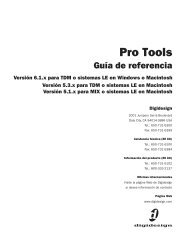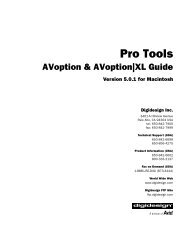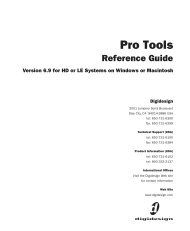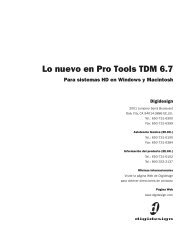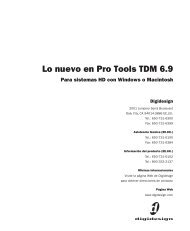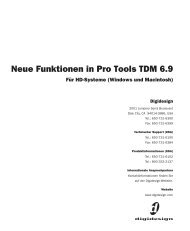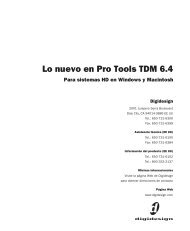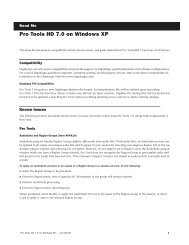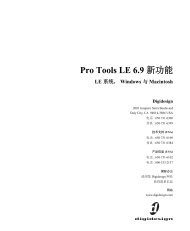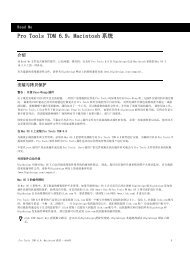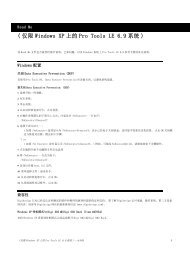5.1 DigiRack Plug-Ins Guide - Digidesign Support Archives
5.1 DigiRack Plug-Ins Guide - Digidesign Support Archives
5.1 DigiRack Plug-Ins Guide - Digidesign Support Archives
Create successful ePaper yourself
Turn your PDF publications into a flip-book with our unique Google optimized e-Paper software.
Process<br />
Clicking this button begins AudioSuite processing<br />
of the selected audio. Processing can occur<br />
during playback (though it may take slightly<br />
longer). Processed files are auto-named with the<br />
region or audio file’s name plus an acronym for<br />
the chosen AudioSuite process.<br />
New files are written to the hard disk specified<br />
for that track in the Disk Allocation dialog, or to<br />
the same drive as the original file if the region is<br />
not currently on a track. See “Auto-File Naming<br />
of AudioSuite-Processed Audio” on page 21.<br />
Multi-channel Processing<br />
<strong>DigiRack</strong> AudioSuite plug-ins allow up to 48<br />
channels of audio to be processed simultaneously.<br />
Undoing AudioSuite Processing<br />
If you have processed an audio selection nondestructively,<br />
the Undo and Redo commands allow<br />
you to undo the selected AudioSuite process.<br />
You can undo/redo an AudioSuite process<br />
during audio playback.<br />
Undo is not available when a plug-in is configured<br />
for destructive editing since the process<br />
has already overwritten the source audio<br />
file.<br />
Auto-File Naming of AudioSuite-<br />
Processed Audio<br />
When new audio files are created as a result of<br />
AudioSuite processing, Pro Tools will auto-name<br />
these files according to the type of plug-in used.<br />
The name of the region determines the prefix,<br />
while the type of AudioSuite plug-in determines<br />
the suffix.<br />
Auto file-naming follows these rules:<br />
◆ New regions are named beginning with the<br />
region name, followed by an abbreviation of the<br />
current AudioSuite process, followed by standard<br />
Pro Tools file and region numbering.<br />
◆ If a plug-in’s File Mode pop-up is set to Overwrite,<br />
the original region’s name will not be<br />
changed.<br />
◆ If a plug-in’s File Mode pop-up is set to Create<br />
Individual Files, the resulting regions will have<br />
an abbreviated version of the plug-in name appended<br />
to them.<br />
Other AudioSuite Parameters<br />
In addition to the standard AudioSuite parameters,<br />
there are a number of special-purpose controls<br />
found on certain plug-ins:<br />
<strong>Plug</strong>-In Librarian/Settings Menus The Settings<br />
and Librarian pop-up menus that appear in<br />
some AudioSuite plug-ins provide a means of<br />
saving, loading, copying, pasting and organizing<br />
custom plug-in settings files. See “Using the<br />
Librarian” on page 13.<br />
Analyze Button Analyzes a selection without actually<br />
processing it. On the <strong>DigiRack</strong> Gain plugin,<br />
the Analyze feature allows you to determine<br />
the maximum peak level on a track at a specific<br />
gain value before you process the audio.<br />
Side Chain Input Selector Selects a track/bus to<br />
be used to trigger processing. In order to use this<br />
feature, the key input source audio must occur<br />
at the same time as the target audio. Side chain<br />
input is monophonic. See “Using a Key Input<br />
for Side Chain Processing” on page 11.<br />
Chapter 3: Working with AudioSuite <strong>Plug</strong>-<strong>Ins</strong> 21



